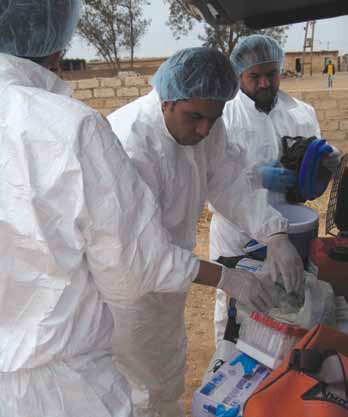In May 2011, the DAFF–FAO Global Partnership on Animal Health was established. The Australian Chief Veterinary Officer, Dr Mark Schipp, is pleased that Australia’s investment under this partnership is paying off.
With support from the Australian Government Department of Agriculture, Fisheries and Forestry (DAFF), the United Nations Food and Agriculture Organization (FAO) has recently achieved notable successes in managing emergency animal diseases in several developing countries and regions.

This image (Figure 1) shows sampling for foot and mouth disease in Libya. Photograph courtesy of FAO.
“Healthy livestock are essential to alleviating poverty and improving public health in developing countries, and DAFF works closely with AusAID and the FAO to fund and otherwise support global efforts to reduce transboundary animal diseases and zoonoses,” said Dr Schipp.
“One area where this type of work is making a real difference is the work of the FAO’s Crisis Management Centre for Animal Health. DAFF recognises the value of the work it undertakes and is pleased to be providing support for this important work,” he said.
The Crisis Management Centre for Animal Health (CMC-AH) was originally established in response to the global spread of the zoonotic disease, H5N1 avian influenza. DAFF and other donors have since supported the CMC to respond to a wider range of animal diseases, including transboundary animal diseases, such as foot-and-mouth disease (FMD). A total of 65 rapid response missions have been conducted in 41 different countries since the centre was established in 2006.For example, in Libya, Egypt and the Palestinian territories, missions were undertaken to provide expert advice on control of FMD. This followed confirmed outbreaks in Libya and Egypt in 2012 of FMD caused by SAT2 virus strains. This was the first time SAT2 FMD virus strains had been reported in Egypt, and the virus strain had not been reported in Libya since 2003.
The CMC-AH mission provided advice to help protect the large ruminant populations at risk in the region. Although FMD is endemic in Libya and Egypt, SAT2 vaccination is not consistently used in these places so animals vaccinated for other strains of FMD virus remain vulnerable.
Control of FMD is important in developing countries because the impact of new introduced strains is severe because of the susceptibility of multiple livestock species. Thus, an outbreak may reduce milk production, decrease weight gain in meat animals, and result in lower offspring numbers. Lameness in working animals may prevent them being used for tilling, transport and the pumping of water for irrigation, and there may be mortalities in young ruminants and swine. The costs of prevention and control, as well as local and international trade restrictions, are also high.CMC-AH also assisted when an unknown disease of cultured shrimp occurred in Viet Nam in 2010 and spread throughout 2011. The disease dramatically affected the $13 billion-a-year industry and resulted in a bleak outlook for the several thousand farmers who rely on shrimp farming as their sole source of income. The CMC-AH mission in that country was able to identify that the cause of the disease was vibriosis. They also provided assistance with re-stocking and developing an aquatic animal health management strategy for follow-up actions.
In Pakistan, the CMC-AH investigated a Newcastle disease outbreak with a puzzling epidemiological pattern. The mission found that a new strain of the poultry disease was spreading (despite vaccination) because pre-existing vaccination regimes did not produce an adequate antibody titre to protect against the new strain. Subsequent recommendations focused on vaccination protocols that maximised immune response.
The CMC-AH also undertook a mission in the Democratic Republic of Congo, where the spread of goat plague (an infectious disease also known as peste des petits ruminants, see EAD Bulletin No. 105, September 2010) has had a devastating impact in the south-west, killing vast numbers of goats and sheep. Because the disease’s spread was observed along road routes (which clearly placed eastern producers at risk from the disease) the mission offered a range of technical advice and arranged FAO funding to support an emergency vaccination program to reduce the spread of the disease and its effects on livestock.

This image (Figure 2) shows a village meeting discusses contagious bovine pleuropneumonia in Gambia. Photograph courtesy of FAO.
In Gambia, the 2012 introduction of contagious bovine pleuropneumonia for the first time in over 30 years resulted in the disease spreading rapidly in the central and upper river areas.
Gambia is highly dependent on its N’dama cattle, which are able to survive conditions other breeds cannot, and many herders lost more than half their N’dama herd. In response, the CMC-AH arranged a vaccination campaign to stop the spread and to protect other villages, and is now providing restocking assistance to affected herders. The FAO’s Ian Douglas, who led the CMC-AH mission in Gambia, recounted an experience at a village meeting that underscores the importance of animal health for people there.
...an elderly lady stepped forward explaining that “these cattle are what sustains us in hard times, what lets our children go to school, what lets us women get married.”The village elder closed with “Before you came we had lost all hope. Now that you have come, from so far away, we have hope again”.
Australia is one of several countries that fund the work of the FAO’s CMC-AH to provide emergency assistance in developing countries affected by infectious animal diseases and zoonoses. Australia also offers technical experts for CMC-AH missions (through DAFF) assessed as qualified to lead or participate in a rapid response mission for transboundary animal disease emergencies.
If you suspect that you have seen a case of an exotic animal disease, please call the Emergency Animal Disease Watch Hotline on 1800 675 888.
Rhyll Vallis
FMD Taskforce
Australian Government Department of Agriculture, Fisheries and Forestry
